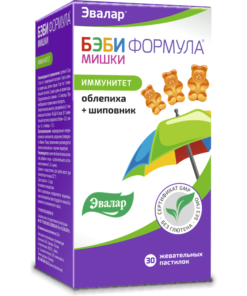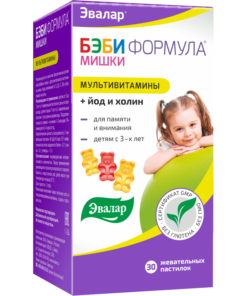$14.76
Delicious chewable vitamin C with orange and lemon flavor. Children from 3 years. 50 mg of ascorbic acid in 1 pastilka.
Children are prone to colds and viral infections more than adults. Each Baby Chewable Lozenge Mishka Lozenges Vitamin C with a pleasant orange or lemon flavor, which children like, contains 50 mg of ascorbic acid, which has an immunostimulating effect, which increases the body’s resistance to infections.
Particularly relevant reception Baby Formula Bears with Vitamin C in the “cold” autumn-winter-spring period.
How do the ingredients work:
Vitamin C (ascorbic acid) is an organic compound related to glucose, which is one of the main substances in the human diet. Vitamin C is necessary for the normal course of many physiological processes in the human body.
The body does not store vitamin C, so we need to get it daily (with food or additionally as supplements).
Biological role of Vitamin C:
Protective function. Vitamin C helps to improve the immunity and resistance of the body to various infections, including viral. Vitamin C in high concentrations is found in immune cells and is quickly consumed in infections. Therefore, the additional intake of vitamin C becomes especially relevant in the autumn-winter period, when the cold season begins. Studies show that supplementation with vitamin C supplements during this period may shorten the duration of the disease.
Antioxidant. Vitamin C is a powerful antioxidant. It protects health from the damaging effects of free radicals, which are formed in the human body in the process of life. In addition to its own antioxidant function, ascorbic acid is needed to restore other antioxidants, such as vitamin E and vitamin A.
Building function. Vitamin C is necessary for the synthesis of collagen and procollagen, which are necessary for the formation of connective tissue in the human body. It forms red blood cells, it is necessary for the full growth and development of bones and tissues.
The necessary level of vitamin C in the body helps to strengthen the gums and blood vessels. Helps to heal wounds and cuts. Vitamin C deficiency provokes bleeding of all mucous membranes.
Vitamin C promotes the absorption of iron in the gastrointestinal tract, so that hemoglobin is normally synthesized in the body.
Detoxification function. Vitamin C is involved in the process of neutralizing a variety of toxic substances, such as tobacco smoke, toxins in the atmosphere of large cities (heavy metals, etc.), toxins of pathogens and many other toxins and poisons. This is true if the child is susceptible to passive smoking or lives in a megacity. In this case, it needs more vitamin C to repair cell damage from cigarette smoke or polluted air.
Enzyme and hormonal function. Vitamin C is necessary for the synthesis of many enzymes and hormones.
Vitamin C is a water-soluble vitamin, and its excess is rapidly excreted in the urine. Therefore, it does not accumulate in the body. Vitamin C has a surprisingly low toxicity. High doses of vitamin C are used for therapeutic effects (for the treatment of diseases).
General recommendations for admission:
Vitamin C should be taken during or after a meal.
Vitamin C and food:
Vitamin C is chemically decomposed under certain conditions, including in the process of cooking. The concentration of vitamin C in various foods decreases with time, in proportion to the temperature at which the food is stored. Cooking vegetables can reduce their vitamin C content by 60%. The loss of vitamin C increases the cooking time, as well as cooking in a copper pot, which catalyses decomposition. Another reason for the loss of vitamin C from food is leaching, when water-soluble vitamin C is dissolved in water, where food is prepared, which is then drained and not consumed. However, not all vegetables vitamin C is washed out at the same rate. Studies show that more vitamin C is stored in broccoli than in any other vegetable. In addition, research has also shown that fresh cut fruits retain significant amounts of nutrients when stored in the refrigerator for several days.
Data on the side effects of vitamin C:
Vitamin C has extremely low toxicity. In a study of 1936, in which 29 children were examined, 93 children of preschool and school age and 20 adults took ascorbic acid in doses up to 6 grams for more than 1,400 days. At higher doses — more than 6 grams (6,000 mg) —toxic manifestations were observed in only five adults and four children. Signs and symptoms of side effects in adults included nausea, vomiting, diarrhea, facial flushing, headache, fatigue and sleep disturbances. Data on vitamin C poisoning to date could not be obtained, since not a single case of poisoning was recorded.
Composition:
starch syrup, sugar, gelatin, ascorbic acid (vitamin C), citric acid (acidity regulator), natural flavors (Orange, Lemon), natural yellow dye (cartamus extract), natural dye (β-carotene), (vegetable oils, carnauba wax).
The presence of particles of starch on the surface of the pastilles.
Nutritional value of 1 chewable lozenge: proteins – 0.2 g, fat – 0 g. Carbohydrates – 1.5 g, energy value (caloric content) – 40 kJ / 10 kcal.
Recommendations for use:
Children from 3 to 7 years on 1 chewing lozenge 1 time a day with meals, children over 7 years of age with 1 chewing lozenge 2 times a day with meals. The duration of treatment is 1-2 months. If necessary, the reception can be repeated.
Contraindications:
Individual intolerance of components, violation of carbohydrate metabolism. Before use, it is recommended to consult a pediatrician.
Shelf life:
2 years
Storage conditions:
Keep out of reach of children at a temperature not exceeding 25 °C.
| Weight | 0.1 kg |
|---|





Reviews
There are no reviews yet.